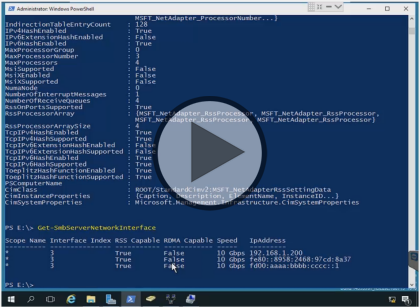Installation, Storage, and Compute with Windows Server 2016, Part 4 of 5: High Availability
with expert Patrick Loner
Course description
This course covers how to ensure Windows systems and infrastructure can stay up and running. It starts with an overview of disaster recovery and availability. Then an overview of options, network load balancing, fault tolerance, planning and configuring fail-over clustering along with how to integrate fail-over with Hyper-V. Finally ending with configuring site availability through stretch clustering.
Prerequisites
there are no prerequisites
Learning Paths
This course will help you prepare for the following certification and exam:
MCSA: Windows Server 2016
70-740: Installation, Storage, and Computer with Windows Server 2016
This course is part of the following LearnNowOnline SuccessPaths™:
Windows Server 2016
Meet the expert
Patrick Loner has certifications for MCSA, MCSE, MCITP, A+, Network+, Security+, and more. He has been working as a Microsoft Certified Trainer, network administrator, and network consultant for over ten years. He has over a decade of experience working with and teaching about Windows networks with client and server operating systems. He has guided many students toward Microsoft and CompTIA certifications. Most recently, he has worked as a freelance trainer and network consultant specializing in Windows Server 2008 and Microsoft Exchange 2007 and Exchange 2010 implementations, design, and upgrades. Patrick continues to branch out now working with and training on Windows Server 2012, Windows 8, Exchange 2013, and System Center Configuration Manager 2012.
Course outline
Introduction to Availability
Overview of Availability and Disaster Recovery (55:09)
- Introduction (01:16)
- Understanding High Availability (06:12)
- Continuous Availability (02:13)
- Business Continuity (02:10)
- Business Continuity Strategies (00:34)
- Developing Disaster Recovery Plans (03:13)
- Service Level Agreements (03:59)
- Highly Available Networking (02:10)
- Highly Available Storage (02:14)
- High Availability for Virtual Machines (05:38)
- Live Migration (05:01)
- Hyper-V Replica (02:14)
- Planning for Hyper-V Replica (01:33)
- Implementing Hyper-V Replica (01:37)
- Overview of Windows Backup (01:53)
- Demo: Windows Backup (05:25)
- Overview of Failover Clustering (02:40)
- HA Through Failover Clustering and Terminology (02:38)
- Clustering Types and Categories (02:11)
- Summary (00:08)
Network Load Balancing (24:43)
- Introduction (00:49)
- Understanding NLB (01:51)
- NLB Operation (01:50)
- NLB Features in Windows Server 2016 (01:22)
- NLB Deployment Requirements (02:21)
- Demo: Deploy NLB (06:04)
- NLB Configuration Options (02:49)
- NLB Host Parameters (01:25)
- Network Considerations for NLB (01:46)
- Planning NLB Implementation (04:14)
- Summary (00:08)
Plan and Create a Failover Cluster
Plan and Create a Failover Cluster (52:57)
- Introduction (00:28)
- The Importance of Planning (01:07)
- Application Considerations (01:47)
- Storage Considerations (00:57)
- Storage Requirements (00:47)
- Hardware Requirements (02:04)
- Network Requirements (01:35)
- Demo: Verify Network Adapter Compatibility (04:19)
- Additional Planning Configurations (03:31)
- Introducing Quorum (02:57)
- Dynamic Quorum (03:34)
- Creation Process (01:40)
- Demo: Create Virtual Disks (04:57)
- Demo: Target Portal (06:13)
- Demo: Format Volumes (11:05)
- Demo: System Configuration (05:41)
- Summary (00:08)
Using Failover Clusters
Failover Cluster Details (16:48)
- Introduction (00:28)
- Cluster Roles (01:27)
- Common Cluster Management Tasks (02:00)
- Cluster Properties (01:12)
- Failover and Failback Configuration (02:25)
- Storage Configuration (01:17)
- Network Configuration (02:41)
- Configuring Quorum Options (01:52)
- Demo: Quorum Configuration (03:16)
- Summary (00:08)
Maintain Failover Clusters (14:58)
- Introduction (00:41)
- Overview of Maintaining Failover Clusters (00:51)
- Monitoring Failover Clusters (03:20)
- Backup and Restore (02:30)
- Troubleshooting Failover Clusters (02:34)
- Managing Cluster Communication (02:30)
- Cluster Aware Updating (02:21)
- Summary (00:08)
Troubleshoot Failover Clustering (11:36)
- Introduction (00:29)
- Troubleshooting Communication (02:50)
- Troubleshooting Cluster Name Objects (04:13)
- Using Event Viewer (02:29)
- Using Windows PowerShell (01:25)
- Summary (00:08)
Failover and Hyper-V (22:47)
- Introduction (00:16)
- High Availability Options (02:37)
- Host Clustering Overview (03:27)
- Clustering for Hyper-V in Windows Server 2016 (01:42)
- Hyper-V Cluster Components (02:18)
- Hyper-V Failover Cluster Prerequisites (02:33)
- Implementation Process (02:12)
- Cluster Shared Volumes (02:34)
- Configuring a Shared VHD (01:26)
- Scale Out File Server (02:46)
- SOFS Requirements (00:42)
- Summary (00:08)
Configure Site Availability (11:41)
- Introduction (00:49)
- Stretch Clustering (01:50)
- Prerequisites for Stretch Clustering (02:49)
- Types of Replication (03:17)
- Overview of Storage Replica (01:10)
- Quorum Models for Stretch Clusters (01:35)
- Summary (00:08)



